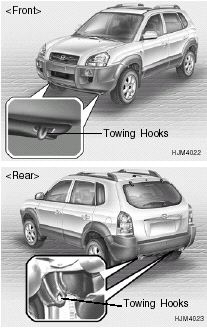Emergency towing

For emergency towing when no commercial tow vehicle is available, attach a tow cable, chain or strap to one of the towing hooks under the front/rear of your vehicle. Be very careful when attempting this procedure when the vehicle is on any unpaved surface to avoid damage to your vehicle.
Nor should towing be attempted if the wheels, drive train, axles, steering or brakes are damaged.
Before towing, be sure the transaxle is in neutral and the key is in "ACC" (with the engine off) or in the "ON" position (with the engine running). A driver must be in the towed vehicle to steer it and operate the brakes.
NOTE:
To avoid serious damage to your 4WD vehicle,
limit the towing to 10 mph and not for
more than 1 mile at ANY TIME.
See also:
Temperature Control
This control is used to adjust the degree of heating or cooling desired. ...
Audio System
NOTE:
If you install an aftermarket HID headlamp, your vehicle's audio and electronic
device may malfunction. ...
Automatic Transaxle Fluid
The fluid level should be in the “HOT” range of the dipstick, after the engine
and transaxle are at normal operating temperature. Check the automatic transaxle
fluid level with the engine running ...


